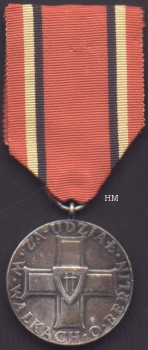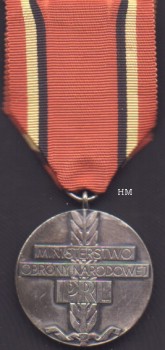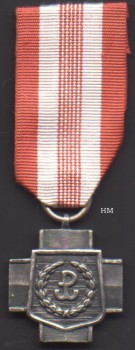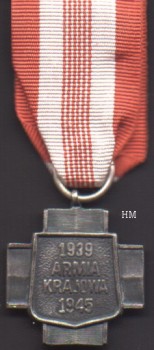

Polish State Awards
|
Order of Polonia Restituta
This order was instituted, in five classes, on 4 February 1921 and was renewed in 1944 with slight alterations to the original design by the National Polish Liberation Committee. The obverse eagle became an uncrowned one and the reverse date was changed to "1944". Where appropriate (breast stars of the 1st and 2nd classes) the centre shows the letters "PRL". The order was awarded for a services in science, art, literature, administration, industry etc. but also for acts of bravery.
Virtuti Militari Order
Originally instituted in 1792, this order was restored a number of times and was even adopted by Russia as a commemorative award. After Polish independence, the order was again reinstituted on 1 August 1919 in five classes, predominantly for gallantry in action although the higher classes were intended for generals who achieved a decisive victory or effected a gallant defence. As with the previous order, the eagle became an uncrowned one in 1944 but the change to "PRL" on the breast stars was not applied and the earlier "PR" was retained.
Cross of Valour
Instituted on 11 August 1920 to reward acts of bravery on the field of battle, the 1920 version of this cross was amended and shows an uncrowned eagle on the obverse as well as the date "1944" on the lower arm. Originally the Polish Government in exile in London adopted a white ribbon with crimson side stripes but later the 1920 ribbon crimson ribbon with white stripes was reintroduced. Subsequent awards were displayed by ribbon bars.
Cross of Merit
Established in 1923 to recognize services to the state, the three classes (gilt, silver, bronze) of this decoration adopted the "PRL" centre for WW2 awards. The reverse of these crosses is blank.
Order of the Grünwald Cross
This order was created, in three classes, on 1 January 1944 to reward outstanding merit in WW2. Afterwards it was also awarded for services in training the Polish armed forces. The obverse shows two swords, relating to an event before the Battle of Grünwald (1410) when the Teutonic Knights sent a blunt sword to the Polish army as an insult. The Poles sent the sword back with a sharp one of their own tied to it, thus showing their acceptance of the challenge. Ther reverse of the decoration shows the letters KG (Krzyza Grünwaldu = Grünwald Cross) and the dates "1410" and "1944". The 1st class of the order is in gilt, the 2nd class in silver with gilt edges and the 3rd class is in silver. Both the 2nd and 3rd class are 45 mm across whereas the 1st class cross is 55 mm.
Medal for Merit on the Field of Glory
First instituted, in three classes (gilt, silver, bronze), in 1943 for participation in the Battle of Lenino, a second type was created in 1944 to reward distinguished services in war actions. The original model depicts, on its obverse, the badge of the Virtuti Militari with a Polish and a Russian flag behind it. The reverse has the text "ZASLUZONYM NA POLU CHWALY 12-13.X.1943 LENINO". The second type is without the flags on the obverse and its reverse retains the title of the medal but without the date and reference to the Lenino Battle, instead of which it bears the year "1944".
Partisan's Cross
This gilt bronze cross was instituted on 26 October 1945 for service with the partisan units. The obverse reads "ZA¨POLSKE WOLNOSC I LUD" (For Polish Freedom and People), the reverse shows "PARTYZANTOM" (To the Partisans) and the dates "1939" and "1945".
Cross for the Silesian Uprising
Instituted on 18 October 1946, this cross commemorates riots and uprisings at Annaberg in 1921 and in Katowice in 1939 and in 1945.
Medal for Warsaw 1939-45
This bronze gilt medal was created on 26 October 1945 for award to Warsaw's 1939 defenders, resistance members of the Warsaw area and those that took part in either the 1944 uprising or the 1945 liberation.
Medal for the Oder, Neisse and Baltic
Also created on 26 October 1945, this bronze gilt medal was awarded to the member of the Polish People's Army that operated in this former German territory.
Victory and Freedom Medal
Again instituted on 26 October 1945, this medal was widely awarded to both military and civilians who had participated in the fight against Nazi Germany, either in Poland or abroad. A 1st type, bearing the letters "KRN" at the top instead of the full title of the instituting body (National Council) and with a half red, half white ribbon, was replaced in 1946 by the type depicted above.
Polish Armed Forces in the West Military Action Cross
This cross was established on 17 May 1989 for award to former members of the Polish Armed Forces of the Exiled Government in London that participated in any campaign. The relevant campaigns are denoted by ribbon bars and the following were created : NARWIK, LAGARDE, MAICHE-St. HIPPOLYTE, BITWA O ANGLIE (Battle of Britain), TOBRUK, MONTE CASSINO, ANKONA, FALAISE-CHAMBOIS, AXEL, ARNHEM, BREDA, BOLONIA, WILHELMSHAVEN, DZIALANIA BOJOWE LOTNICTWA (Air Force war operations), BITWY I KONWOJE MORSKIE (sea battles and convoys).
Auschwitz Cross
In spite of its title, this cross, instituted on 14 March 1985, was awarded to honour inmates of any Nazi concentration camp and not only those interned in Auschwitz. Honourable conduct while imprisoned was a prerequisite and the decoration could be awarded posthumously and to foreigners as well. The reverse inscription stands for "The People's Poland to Prisoners of Nazi Concentration Camps".
War Medal 1939
This silvered medal was created on 7 July 1981 for award to veterans of the Polish Armed Forces, the Border Corps, the National Defence Forces and other organisations that participated in the defence of Poland in September and October 1939.
Warsaw Uprising Cross
Instituted on 7 July 1981 for award to military or civilian
participants in the 1944 Warsaw Uprising. The silvered cross bears the date "1 VIII
1944" and shows the insurgents' white and red armband in the centre. The letters
"PW" stand for "Fighting Poland" while the reverse inscription means
"To the insurgents of Warsaw". Battle of Lenino Cross
To commemorate the Battle of Lenino (at present in Byelorussia) which was fought on 12 October 1943 and which was the first battle in which units of the Polish People's Army, formed in the Soviet Union, participated, this silvered cross was created on 26 May 1988. Both the decoration's eagle and ribbon colours refer to the 1st Kosciuszko Infantry Division which took part in the battle.
Created as a commemorative cross on 26 July 1944 by the Commander-in-Chief of the Polish Armed Forces of the Government in exile, General Sosnkowski. The dark bronze cross, with a serial number on its reverse, was awarded to members of the 2nd Polish Army Corps.The obverse reads "MONTE CASSINO MAJ 1944". The ribbon bar depicted on the cross above is a non-regulation addition. A similar smaller bar, but in bronze, can be attached to the ribbon when ribbons alone are worn. The Monte Cassino Cross was elevated to an official Polish decoration on 16 September 1992.
Peasant Battalions' Cross
Elevated to a state decoration on 16 September 1992, this
cross started life on 28 December 1988 through a decision of the Presidium of the United
People's Party, a largely rural oriented political party. It was awarded to veterans of
the Peasant's Battalions, an independent military resistance organisation, operating in
the rural areas of Poland during WW2. National Military Action Cross
Another decoration to enter the state's awards system (on
16 October 1992) is this cross which was originally instituted on 14 December 1944 by the
National Armed Forces, an independent nationalist military organisation, and awarded to
its members for their services during the war. The reverse inscription reads
"National Military Achievement". Grünwald Badge |
 |
 |
Those serving with the People's Army in the Berlin operations in April and May 1945, as well as others in active service in that period, received this commemorative medal. It was instituted on 21 April 1966 and is conferred by the Minister of National Defence (making this a ministerial award rather than a state decoration). The obverse shows the badge of the Grünwald Cross Order and the surrounding text reads "For Participation in the Battle of Berlin". The reverse has the inscription "Ministry of National Defence People's Republic of Poland".
Home Army Cross
 |
 |
General Bor-Komorowski, former commander of the "Home
Army", created this commemorative medal on 1 August 1966 for award to former Home
Army members or members of resistance organisations which preceded the Home Army. The
medal was elevated to a state decoration on 16 September 1992.
Copyright Hendrik Meersschaert 2025 ©